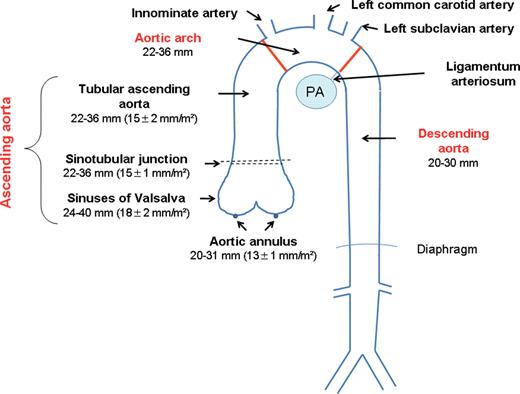-
PDF
- Split View
-
Views
-
Cite
Cite
Arturo Evangelista, Frank A. Flachskampf, Raimund Erbel, Francesco Antonini-Canterin, Charalambos Vlachopoulos, Guido Rocchi, Rosa Sicari, Petros Nihoyannopoulos, Jose Zamorano, on behalf of the European Association of Echocardiography; Document Reviewers: Mauro Pepi; Ole-A. Breithardt; Edyta Plońska-Gościniak, Echocardiography in aortic diseases: EAE recommendations for clinical practice, European Journal of Echocardiography, Volume 12, Issue 8, August 2011, Page 642, https://doi.org/10.1093/ejechocard/jer145
Close - Share Icon Share
European Journal of Echocardiography 2010 11: 645–658 doi:10.1093/ejechocard/jeq056
An error occurred in Figure 4, ‘Echocardiography in aortic diseases: EAE recommendations for clinical practice’, published in European Journal of Echocardiography (2010) 11, 645–658. The normal diameter size of sinuses of Valsalva is 29–40 mm (18 ± 2 mm/m2) as it is included in the figure below. The authors apologize for this error.

Normal size of thoracic aortic segments. The thoracic aorta can be divided into three segments: the ascending aorta that extends from the aortic annulus to the innominate artery and is typically measured at the level of the aortic annulus, the sinuses of Valsalva, the sinotubular junction, and the proximal (tubular) ascending aorta; the aortic arch that extends from the innominate artery to the ligamentum arteriosum; and the descending aorta that extends from the ligamentum arteriosum to the level of the diaphragm. PA, right pulmonary artery. Modified from Diseases of the aorta. In: Feigenbaum H, Armstrong WF, Ryan T, eds. Feigenbaum's Echocardiography. 6th ed. Philadelphia, PA: Lippincott Williams & Wilkins; 2005. p673; Ascending aorta values from Erbel et al.46



